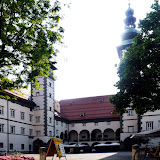

A route between Italy and Austria, or between Friuli and Carinthia, that follows the rivers Gail and Drava and at its end, upon arrival at Klagenfurt, the Wörthersee (Lake Wörth); there is very little difficulty with altimetry and only a few short climbs. Going in the direction I describe below the route is predominantly in descent.
Point of departure is the train station at Tarvisio Boscoverde on the Venezia-Vienna line, easily reached from Venice, Udine and Trieste. Unfortunately the train that goes in the morning runs only on Sundays; since 2012 from Udine to Villach there is also a new connection by MiCoTra, but limited to two trips per day.
Upon leaving the station to the west you will be in a small piazzale where the Tarvisio-Jesenice bike route runs on the far side; take this to the left as far as a small connector to the right which takes you to a bridge over the river Slizza and a small rest area; we are now at the Alpe-Adria bike path, which we will take to the right heading towards the border with Austria. When you come to the tunnel it is necessary to get on the statale [state highway] as far as the border; alternatively there is an attractive bike path through the woods, but with many steep climbs and descents; after crossing the border the Austrian section of the Alpe-Adria bike route begins, with the name Tarviser Radweg; the first section is a bike lane on the left of federal highway B83 (B for Bundesstrasse).
The bike path ends at Arnoldstein in front of a supermarket; from here you need to go along the federal highway on a stretch of bike lane on the right; at Neuhaus we take the small road to the left that takes us to a railroad overpass which takes us to a bridge over the river Gail; here we reach the Gailtalradweg (bike route of the Gail valley), with an unpaved surface but bike-able, constantly following the river, even though the dense foliage hides much of it and, very pleasant during the summer, makes the bike path feel shaded and cool.
At Villach you pass under the vast railroad yards of Villach Warmbad and under a super-high viaduct; here begins the urban part of the bike route, it is paved. In the center of the suburb of Maria Gail an arrow directs you to leave the Gail, which at this point is about to flow into the Drava; we follow the bike lane along a road overlooking industrial buildings, while in the distance you can see, distinct because of its red color, the Friedensbrücke (bridge of peace) over the Drava; upon coming to the bridge get into the bike lane, which curiously runs down the middle between the two vehicular lanes.
Just beyond the bridge we find ourselves on the Drauradweg (R1) one of the longest bike paths in Austria; it runs along the left side of the river, with sweeping views of the valley. As of July 2013 shortly after Föderlach the bike path is interrupted and you are forced to climb a steep and unpaved road to the village of Emmersdorf, where one finds the rather busy road to Velden.
After crossing through Velden, a not entirely painless enterprise in the summer and on Sundays when traffic and crowding are significant, we arrive at Lake Wörth (Wörthersee) and here the bike route runs mostly on a bike lane next to road B83, and occasionally even along the lake.
Upon arriving at the eastern end of the lake we are already on the outskirts of Klagenfurt (whose official name is Klagenfurt am Wörthersee); you pass near Minimundus, a park that reproduces in miniature many cities of the world, and past the buildings of the university.
Klagenfurt is the capital and largest city of Carinthia with about 100,000 inhabitants. We find yet again an extensive and well-connected network of bike paths. The city center is the Neuer Platz [new square] with the famous dragon fountain (Lindwurmbrunnen), symbol of the city, and the monument to Maria Theresa, Empress of Austria.
At Klagenfurt there is a train station; to return to Italy there are frequent trains to Villach, where since 2012, there are two daily regional trains that run express to Udine. Unfortunately the schedules are not coordinated so that the return trip requires almost 6 hours of travel. There is also an intercity bus that runs direct to Venice but it doesn’t carry bikes and even then it takes almost 5 hours. One hopes that sooner or later it will be replaced with a more comfortable and rapid intercity train service, that carries bikes as do most of the trains in Austria.
Latest visit:

|
|
Klagenfurt am Wörthersee
|